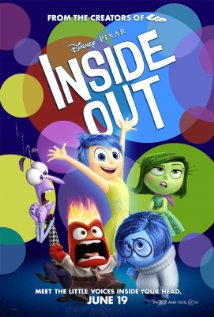
INSIDE OUT
US, 2015, 94 minutes, Colour.
Voices of: Amy Poehler, Phyllis Smith, Bill Hader, Mindy Kaling, Lewis Black, Diane Lane, Rashida Jones, Kyle Mac Lachlan, Frank Oz, John Ratzenberger.
Directed by Pete Docter, Ronaldo del Carmen.
Over the past 15 years or so, the Pixar Studios, now associated with Disney, have stood out as the go-to studio for fine animation films. While they made their mark with the Toy Story series, they had a series of successes, and Oscar wins and nominations, with films like Finding Nemo, The Invincibles, Cars, Ratatouille, Wall-E, Up. Some of their productions have been slighter in recent years, especially Cars 2, but Inside Out should put them up there on top again.
The idea is rather original. What if we went inside the characters heads, identified some of the chief emotions, imagine what they might look like in cartoon form, how they operate in harmony with and in conflict with each other, determining the reactions of the character?In this case it is a young baby, Riley, whom we look out from the outside but then go inside her mind, discovering Joy, the most exuberant and exhilarating emotion.
But then babies cry! The emotion which emerges is Sadness, again a feminine voice, something of a sad sack, low on self-image and esteem, prone to blame herself for making the child unhappy. The screenwriters have decided on three other emotions, Fear (a really nervous type who wants to be over-protective, a male voice), Anger, a squashed looking character, also male, and, Disgust, a somewhat petulant and arrogant female voice.
Each of the emotions has its own special colour. Joy is a bright yellow while Sadness is blue. Disgust is green, while Anger is definitely red!
As Riley grows up, we see each of the emotions influencing the young girl. When her loving parents move house, she gets upset, Joy and Sadness becoming lost, as if on another planet, while Fear, Anger and Disgust are in turmoil within her, even leading her to run away from, and catch a bus, petulant and angry with her parents.
In the meantime, the audience sees that Joy and Sadness are lost, trying to find their way back into Riley’s mind, and accompanied by her invisible childhood friend, Bingbang.
Joy has to come to realise that she just simply can’t eliminate Sadness from every human experience. Sadness is a necessary part of life and, when Joy is able to acknowledge this, trusting Sadness to have her influence, there is a possibility of some kind of recovery and harmony.
Which means that the film is a very nice allegory about human emotions, visualised entertainingly, all at work on a kind of inner computer to try to help the child’s growth but, squabbles arising, envy sometime prevailing, leading to enormous confusion.
The end of the film as well as the initial parts of the final credits are well worth seeing for laugh-aloud responses, seeing the emotions within the minds of Riley’s parents as, faces-painted, they go to support her at a hockey match. One of the funniest scenes is momentarily inside the mind of a very gawky boy who encounters Riley with the emotions running riot in his mind. There is also a school teacher, a frustrated bus driver – and then, the emotions within a dog and within a cat.
Obviously, plenty of room for an imaginative sequel, even a series.
1. The Pixar film, imagination, style?
2. The title, the idea, visualising the in the world, emotions, conflict, dominance, loss, re-gaining, hope?
3. The animation style, the visuals, the characters, the voice cast? Cartoon style, computer-generated? The humans? The emotions? The picture of ordinary life, family life? The mind and the inner computer? The different lands, planets, train of events? Destruction, building? The variety of colours? The musical score?
4. The attraction to Joy, Sadness, Anger, Fear, Disgust?
5. The birth of Riley? Audiences looking on? Her eyes looking out? The experience of joy? The parents, the gradual emergence of Sadness, moments of Fear, elements of disgust, Anger and situations? The memory balls and their storage, colours, the emotions and access?
6. Riley and her childhood, the various incidents, plain, friends, the games, the house? Changing house? Sadness emerging? Life becoming grim, dark? Running away, the dark street, the bus?
7. Joy, her look, bright, cheerful voice, exuberant personality, not wanting Sadness to touch the memories? Interacting with the other emotions? Her becoming lost, lost with Sadness? With Bingbang, the childhood imaginary playmate? Sadness searching? Joy in the dark? With Bingbang, getting the cart, trying to go higher, the energy? Bingbang getting off, Joy’s leap? Her seeing Bingbang, his farewell, his gradually disappearing? The mission to find Sadness? The others in the mind, the confusion, the inner computer not working?
8. Sadness, colour, blue? Downplaying herself, lower self-image, thinking that she spoilt everything, touching the balls and their turning to blue, her being lost, wanting to escape? Meeting up with Joy, Joy allowing the touch, real feelings and tears emerging in Riley, sadness taking over, the catalyst for discovering memories of the truth, her tears, coming to her senses, recovering joy?
9. The comic touch of Fear, ultra-protective? Disgust and being green, suspicious, looking down on others? Anger, rage, red? These emotions as characters, their interactions?
10. Bingbang, childhood friend, helping, disappearing?
11. The return of Joy and Sadness? The emotions in order? Riley talking to her parents, their support of her? The good memories returning, hockey, friends, support? Going to play, her parents and their painting their faces, in the stadium?
12. The final jokes, laugh out loud: the emotions inside the parents, the confusion inside the gawky boy, the teacher trying to cope, the bus driver? The various feelings for the dogs, the cats?
13. A pleasing allegory for children of all ages?